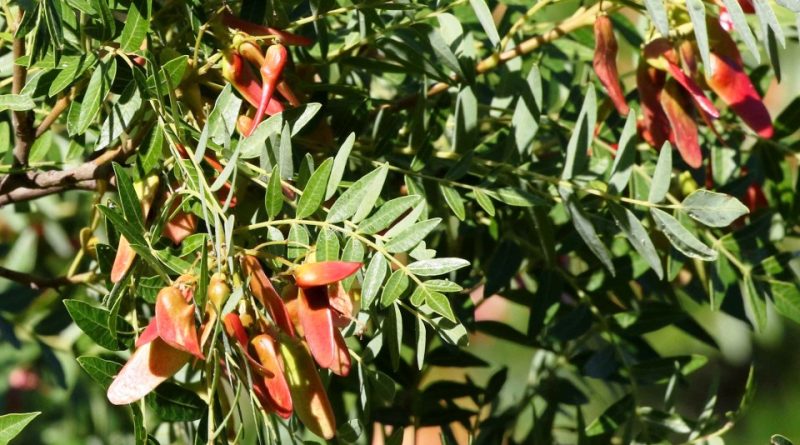Schinopsis lorentzii
Schinopsis lorentzii
The Quebracho colorado or santiagueño or red quebracho (Schinopsis lorentzii (Griseb.) Engl.) is an arboreal species belonging to the Anacardiaceae family.
Systematics –
From a systematic point of view it belongs to:
Eukaryota Domain,
Kingdom Plantae,
Magnoliophyta Division,
Magnoliopsida class,
Sapindales Order,
Anacardiaceae family,
Genus Schinopsis,
S. lorentzii species.
The terms are synonymous:
– Aspidosperma quebracho-colorado Schltdl.;
– Loxopterygium lorentzii Griseb.;
– Quebrachia laurentzii Griseb.;
– Quebrachia lorentzii (Griseb.) Griseb.;
– Schinopsis heterophylla Ragon. & J.Castigl.;
– Schinopsis lorentzii (Griseb.) Engl.
– Schinopsis quebracho-colorado (Schltdl.) F.A.Barkley & T.Mey..
Etymology –
The term Schinopsis comes from schino, from the Latin Schinus and from the Greek σχῖνος “mastic”, therefore resembling the Lentisk.
The specific Lorentzii epithet of the species is in honor of the botanist Paul (Pablo) Günther Lorentz (1835-1881), German naturalized Argentine, professor of botany in Argentina and Uruguay.
Geographic Distribution and Habitat –
Schinopsis lorentzii is a plant native to the subtropical area of Paraguay, where it forms forests in the Gran Chaco region of Argentina, Paraguay and Bolivia.
Its natural habitat is that of arid plains, in small groups mixed with other broad-leaved trees in open populations.
Description –
Schinopsis lorentzii is a broad-leaved tree that grows from 20 to 25 meters in height.
The trunk is moderately straight and can have a diameter of 30 – 80 cm; moreover it is devoid of branches for the first 8 – 10 meters.
The leaves are lanceolate, opposite, with evident veins and a bright green color.
The relatively small and regular flowers are collected in inflorescences.
The fruits are drupes.
Cultivation –
Schinopsis lorentzii is a tree that grows mainly in subtropical areas but also in tropical ones.
This plant prefers clayey or clayey-sandy soils
It is a highly sought-after plant for its wood; due to its massive exploitation, 85% of the native forests of Quebracho in Argentina have been lost.
The plant can however be cultivated and its propagation is essentially by seed.
Customs and Traditions –
Schinopsis lorentzii is a plant from whose bark is obtained the extract of quebracho used for tanning and dyeing.
This plant is considered a symbol of the Gran Chaco region. This tree is commercially very important for its extremely hard and resistant wood and its tannin. The tanning industry has been exploiting the quebracho forests for over 100 years, with a notable depletion, as mentioned, of natural resources.
Wood is particularly appreciated as a source of tannins, which are extracted on an industrial scale.
Thanks to its great durability, wood is also used for a wide range of uses, especially for items that have to face bad weather and humidity.
Remember that sawdust can cause headaches, dermatitis and asthma.
The bark and wood contain 18 – 20% of excellent quality tannins. The heartwood, on the other hand, contains 22 – 24% of tannins.
The heartwood is chestnut red, sometimes with black streaks; it is clearly demarcated by the 25 – 75 mm wide band of the whitish-pink sapwood. The wood is moderately bright; the consistency is fine and uniform; the grain is intertwined with an undistinguished odor; astringent flavor. The wood needs care in seasoning; it has a marked tendency to deform, especially if transformed into thin boards in a green state. It is rather difficult to work both by hand and by machine; pre-drilling is required for nailing and screwing; tends to chip when drilling; it dyes well and takes a high polish. The wood is fireproof and very durable, it is not easily attacked by insects. Due to its great durability, it is mainly used for outdoor purposes such as railway poles and sleepers.
Wood is an excellent fuel, with low combustion and high calorific value.
In addition to this, as mentioned, Schinopsis lorentzii is used in the leather tanning industry and in dry cleaners.
This plant also has a medicinal use in folk medicine in the areas of origin and, in the laboratory, it has been possible to ascertain the in vitro inhibitory activity of an extract of this plant, composed of polyphenols and catechins on some pathogenic bacteria.
Preparation Method –
Of Schinopsis lorentzii, in addition to the uses for wood and the extraction of tannins, wood extracts can be used in folk medicine in the areas where the plant grows.
Guido Bissanti
Sources
– Acta Plantarum – Flora of the Italian Regions.
– Wikipedia, the free encyclopedia.
– Useful Tropical Plants Database.
– Conti F., Abbate G., Alessandrini A., Blasi C. (ed.), 2005. An annotated checklist of the Italian vascular flora, Palombi Editore.
– Pignatti S., 1982. Flora of Italy, Edagricole, Bologna.
– Treben M., 2000. Health from the Lord’s Pharmacy, Advice and experiences with medicinal herbs, Ennsthaler Editore.
Photo source:
– http://sweetgum.nybg.org/images3/3032/843/03687695.jpg
Warning: Pharmaceutical applications and alimurgical uses are indicated for informational purposes only, they do not represent in any way a medical prescription; therefore no responsibility is taken for their use for curative, aesthetic or food purposes.


